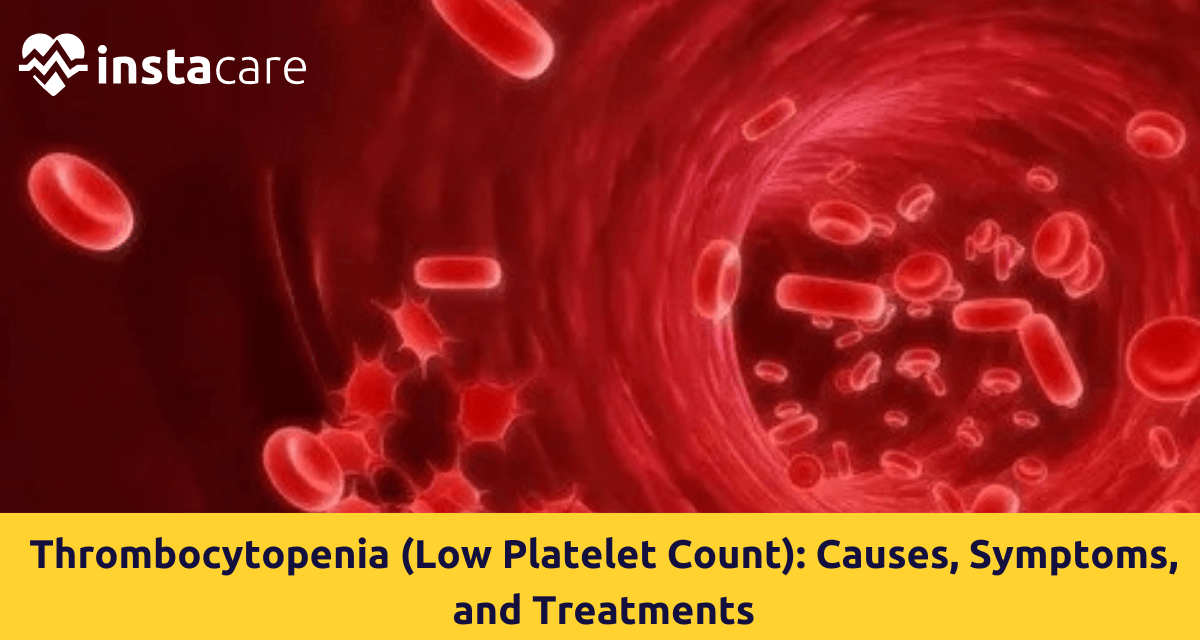Thrombocytopenia, or deficiency of platelets, is a blood disorder caused by a decreased count of platelets in the blood. Platelets are used for healing and clotting, and upon staying short, lead to bleeding in the body. It is benign or asymptomatic and can even be life-threatening, depending on the extent of deficiency and cause.
Thrombocytopenia is due to a medical condition, drug side effect, infection or treatment-related side effect, i.e., chemotherapy. There will be spontaneous recovery in some and therapy along with follow-up for years for others. Recognizing cause and treatment will stop potentially life-threatening complications, particularly in high-risk cases like pregnancy and children.
What is Thrombocytopenia?
Thrombocytopenia is a condition in which you have a low blood platelet count.
Platelets (thrombocytes) are colorless blood cells that help blood clot. Platelets stop bleeding by clumping and forming plugs in blood vessel injuries.
Platelets or thrombocytes are small pale pieces of blood cells whose major function is to prevent bleeding by clumping and plugging vessel injuries. If the clotting process in the body is disrupted when platelets are lost. It may be detected by easy bruising, unusual bleeding when a minor cut has been incurred, or spontaneous attack bleeding depending on how low the platelets are.
Some of the Causes of Thrombocytopenia
There are several etiologies for thrombocytopenia and can be best explained under three: decreased platelet production, enhanced platelet destruction, and sequestration (platelet sequestration in the spleen).
- Reduced production of platelets can be seen in Bone marrow disorders and thrombocytopenia, such as leukemia, aplastic anemia, and other bone marrow. Irradiation and chemotherapy inhibiting the bone marrow is one type of reduced production of platelets.
- Excessive platelet loss results from autoimmune disorders like immune thrombocytopenia (ITP) or idiopathic thrombocytopenic purpura where the immune system of the body destroys normal platelets unnecessarily. Some drugs and some viruses also do the same.
- Platelet sequestration happens whenever a splenomegaly sequesters more than usual for the number of platelets, with those that are left circulating in the blood.
- Low platelets in children occur most frequently following viral illness or infection and will be transient which can be protracted. They are typical adult attacks which will be fairly suggestive of autoimmune or hematologic disease. Low platelets in pregnancy also occur frequently and are usually benign but need to be watched if platelets drop.
Few Symptoms of Low Platelet Count
Symptoms vary according to the severity of platelet deficiency. When in small numbers, no symptom occurs and the disease occurs only upon a normal blood examination.
During initial development of symptoms, likely to appear first are:
- Bruising easily or bruising spontaneously
- Cutting or bleeding after injury for long periods
- Pink or purple red spots on skin (petechiae)
- Multiple nosebleeding or gumbleeding
- Heavy menstrual bleeding
- Passing blood stools or passing bloody urine in terminal cases
Petechiae and purpura (larger lesions of blood in the skin) are seen more frequently with immune thrombocytopenia (ITP). Fatigue or irritability, combined with active or occult bleeding, also may be present in children with thrombocytopenia in children.
What Are the Risk Factors for Low Platelet Count?
There are few risk factors which can increase greater risk of getting thrombocytropenia:
- Bone marrow function faces suppression as a side effect of chemotherapy and cancer therapy so low platelet count generally appears as one of those complications.
- Lupus and rheumatoid arthritis together with other autoimmune conditions affect the bone marrow functions.
- Viral infections such as HIV, hepatitis C, or Epstein-Barr virus.
- Alcoholism or chronic toxic exposure.
- Pregnancy, since pregnancy-associated low platelet count is seen in up to 10% of pregnant women, typically in the third trimester.
- Idiopathic thrombocytopenic purpura or familial platelet disorder family history, positive.
What Includes the Diagnosis of Thrombocytopenia?
The diagnosis is usually started with a CBC, or screening of all the blood parameters including platelets. If low-normal platelet number, additional tests may be done to try to identify the cause.
Physicians can test for:
- Evidence of infection or autoimmune disease.
- Level of antibodies for the diagnosis of immune thrombocytopenia (ITP).
- Bone marrow biopsy in bone marrow abnormality and thrombocytopenia.
- Imaging studies, like ultrasound, to check for spleen size.
In kids with thrombocytopenia, the diagnosis tends to eschew invasive procedures if the symptoms are deteriorating or occurring chronically alone.
Some Treatment Options for Thrombocytopenia
Treatment depends on causation and severity. Symptom-free or only mildly symptomatic individuals can be overlooked but put under close surveillance. Where platelets are low enough to cause a problem or on bleeding, the disease has to be immediately treated.
- Medications: Corticosteroids typically are first treatment of immune thrombocytopenia or idiopathic thrombocytopenic purpura. Corticosteroids inhibit the pounding activity of the immune system on platelets. IVIG or anti-D immune globulin sometimes is used to transiently increase platelet count.
- Correction of the Underlying: Condition Correction of platelet count will follow treatment of underlying infection or drug in case of infection or drug-induced thrombocytopenia. For example, removal of offending drug or infection will correct thrombocytopenia.
- Platelet Transfusions: They are usually reserved for those with severe thrombocytopenia, particularly when the platelets fall below 10,000 per microliter or active bleeding. Chemotherapy and low platelets are transfused too.
- Support through Diet and Lifestyle: Although not a cure, weight loss through elimination of Foods to increase platelet count can be part of the healing process and overall well-being. Folate-containing foods, vitamin B12, vitamin K, iron (spinach, oranges, lean meat) are some that contribute to platelet production.
- Surgery: In severe or chronic immune-mediated disease, splenectomy may be tried when other treatment fails. It is more commonly done in recurrent idiopathic thrombocytopenic purpura.
- Special Considerations during Pregnancy and in Children: Except in cases with low platelets, pregnancy-associated thrombocytopenia is treated conservatively. Also, in a majority of child cases of thrombocytopenia, spontaneous improvement over weeks is present.
Conclusion
Thrombocytopenia is a heterogeneous illness and multiple levels of prognosis ranging from benign to eventually life-threatening. Thrombocytopenia can be or may not be secondary to autoimmune disease, bone marrow dysfunction, chemotherapy, or infection. Knowledge of its etiology is the key to its optimum management. Early identification of its symptoms, accurate diagnosis, and appropriate management appropriate to the patient will treat the illness to the best advantage.
Caution must be observed in pregnant females and children, where follow-up and supportive therapy lead to a complete cure to a considerable extent. Education in drugs, diet history and drug platelet-aggravating supplements can be preventive as well.
Please book an appointment with the
best Hematologist in Lahore, Karachi, Islamabad, and all major cities of Pakistan through
InstaCare, or call our helpline at 03171777509 to find the verified doctor for your disease.

